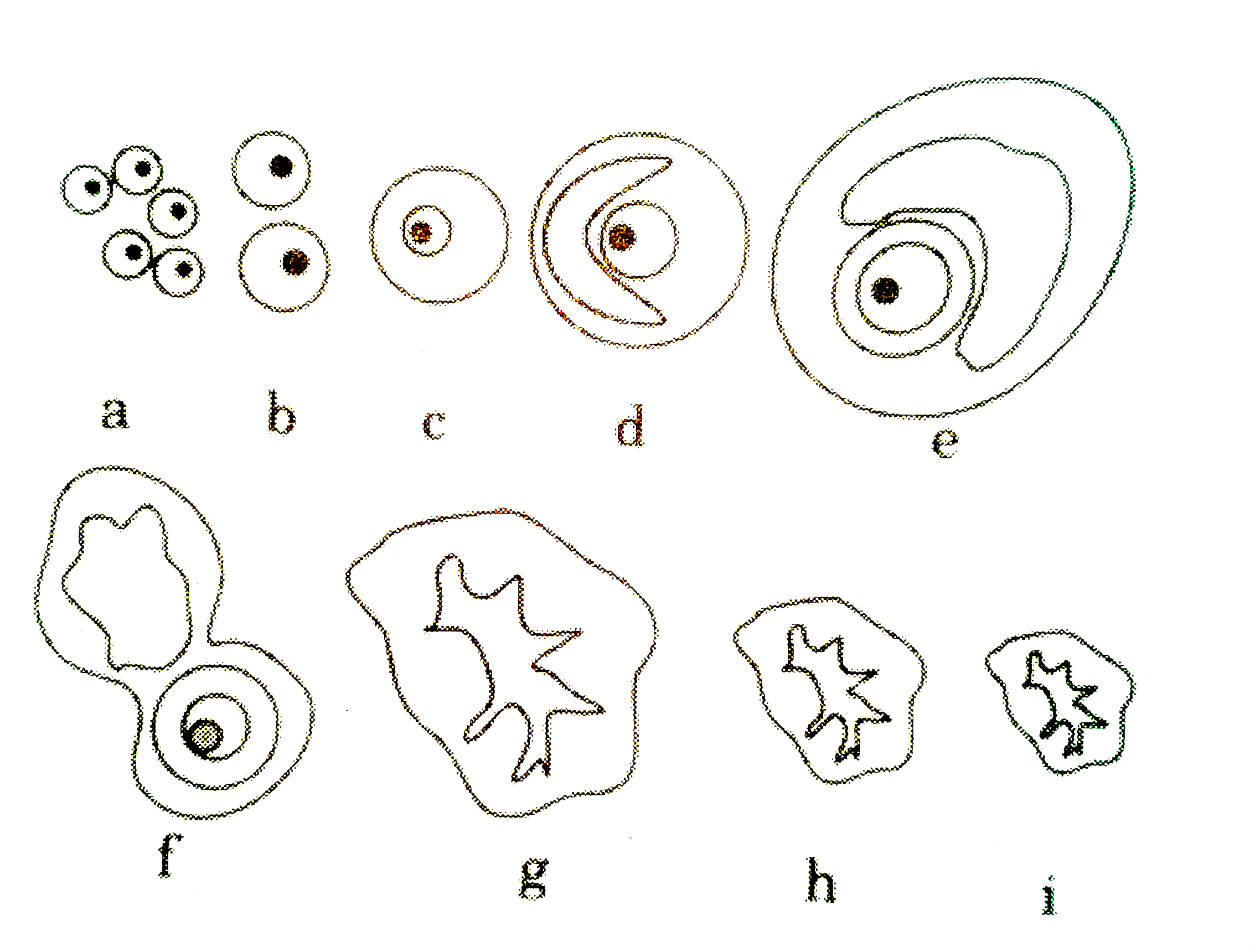The following is the illustration of the sequence of ovarian events (a-i) in a human female.

(a) Identify the figure that illustrates ovulation and mention the stage of oogenesis it represents.
(b) Name the ovarian hormone and the pituitary hormone that have caused the above mentioned events.
(c) Explain the changes that occurs in the uterus simultaneously in anticipation.
(d) Write the difference between C and H. Solution in Tamil
(a) A- Primordial follicle, B- Primary follicle, C- Secondary follicle, D-Tertiary follicle, E- Mature graafian follicle, F- Ovulation (release of egg), G- Empty Graafian follicle, H- Corpus luteum, I - Corpus albicans.
(b) Pituitary hormones: Follicle Stimulating Hormones (FSH) and Lutenizing Hormone (LH). Ovarian hormones: Estrogen and Progesterone.
(c) At the start of menstrual cycle, the endometrium of uterus starts regenerating through proliferation of cells induced by FSH and CH. After ovulation, the progesterone secreted by corpus luteum prepares the endometrium (uterine wall) to receive the egg if it is fertilized.
(d) C- Secondary follicle H - Corpus luteum During development of ovum, the primary follicle gets surrounded by many layers of granular cells and forms a new layer called secondary follicle. Corpus luteum is the empty graafian follicle that remains after ovulation. It acts as a transitory endocrine gland secreting progesterone to maintain pregnancy.
Topper's Solved these Questions
- HUMAN REPRODUCTIONBOOK - FULL MARKSCHAPTER - HUMAN REPRODUCTIONEXERCISE - Additional Questions (1 Marks Questions)
34 Videos
- HUMAN REPRODUCTIONBOOK - FULL MARKSCHAPTER - HUMAN REPRODUCTIONEXERCISE - Additional questions (2-marks questions)
29 Videos
- Human health and diseasesBOOK - FULL MARKSCHAPTER - Human health and diseasesEXERCISE - Additional questions - Higher order thinking skills(HOTs)Questions
3 Videos
- MICROBES IN HUMAN WELFARE BOOK - FULL MARKSCHAPTER - MICROBES IN HUMAN WELFARE EXERCISE - Higher Order Thinking Skill (HOTs) Questions
4 Videos
Similar Questions
The developing spermatoza are nourished by............
View SolutionEnumerate the functions of reproductive system.
View SolutionIdentify the mismatched pair and give reason.
(a)Plague-Yersinia pestis
(b)Filariasis-Wuchereria bancrofti
(C )Dermatomycosis-Trypanosoma gambiense
(d)Common cold -Rhino virus
View SolutionOne can notice large holes in Swiss cheese . Which bacterium is responible for these holes . What are these holes due to ?
View SolutionExplain the ovarian and uterine events that occur during a menstrual cycle in a human female, under the influence of Pituitary and Ovarian hormones respectively.
View SolutionComment on the corresponding ovarian and pituitary hormone levels during these events.
View SolutionThe following is the illustration of the sequence of ovarian events (a - i) in human female.
ltimg src="https://d10lpgp6xz60nq.cloudfront.net/physics_images/SB_BIO_XII_SET_I_2012_E01_032_Q01.png" width="80%"gt
(i) Identify the figure that illustrates ovulation and mention the stage of oogenesis it represents.
(ii) Name the ovarian hormone and the pituitary hormone that have caused the above mentioned event.
(iii) Explain the changes that occur in the uterus simultaneously in anticipation.
(iv) Write the difference between 'c' and 'h'
(v) Draw a labelled sketch of the structure of a human ovum prior to fertilization.
View SolutionThe following is the illustration of the sequence of ovarian events (a - 1) in a human female. (a) Identify the figure that illustrates ovulation and mention the stage of oogenesis it represents.
(b) Name the pituitary hormone that has caused the above mentioned event.
(c) Explain the changes that occur in the uterus simultaneously in anticipation
(d) Write the differences between 'c and 'h'.
(e ) Draw a labelled sketch of the structure of a human ovum prior to fertilization.

View SolutionThe following is the illustration of the sequence of ovarian events "a" to "I" in a human female : Identify developing follicle, mature follicles and corpus luteum.
View SolutionThe following is the illustration of the sequence of ovarian events (a-i) in a human female.

(a) Identify the figure that illustrates ovulation and mention the stage of oogenesis it represents.
(b) Name the ovarian hormone and the pituitary hormone that have caused the above mentioned events.
(c) Explain the changes that occurs in the uterus simultaneously in anticipation.
(d) Write the difference between C and H.
View SolutionExplain the ovarian and uterine events that occur during a menstrual cycle in a human female, under the influence of Pituitary and Ovarian hormones respectively.
View SolutionThe following is the illustration of the sequence of ovarian events (a - i) in human female.
ltimg src="https://d10lpgp6xz60nq.cloudfront.net/physics_images/SB_BIO_XII_SET_I_2012_E01_032_Q01.png" width="80%"gt
(i) Identify the figure that illustrates ovulation and mention the stage of oogenesis it represents.
(ii) Name the ovarian hormone and the pituitary hormone that have caused the above mentioned event.
(iii) Explain the changes that occur in the uterus simultaneously in anticipation.
(iv) Write the difference between 'c' and 'h'
(v) Draw a labelled sketch of the structure of a human ovum prior to fertilization.
View SolutionDesribe the roles of pituitary and ovarian hormones during the menstrual cycle in a human female .
View SolutionThe following is the illustration of the sequence of ovarian events (a - i) in human female.

(i) Identify the figure that illustrates ovulation and mention the stage of oogenesis it represents.
(ii) Name the ovarian hormone and the pituitary hormone that have caused the above mentioned event.
(iii) Explain the changes that occur in the uterus simultaneously in anticipation.
(iv) Write the difference between 'c' and 'h'
(v) Draw a labelled sketch of the structure of a human ovum prior to fertilization.
View SolutionThe following is the illustration of the sequence of ovarian events (a - 1) in a human female. (a) Identify the figure that illustrates ovulation and mention the stage of oogenesis it represents. (b) Name the pituitary hormone that has caused the above mentioned event. (c) Explain the changes that occur in the uterus simultaneously in anticipation (d) Write the differences between 'c and 'h'. (e ) Draw a labelled sketch of the structure of a human ovum prior to fertilization.
View Solution
